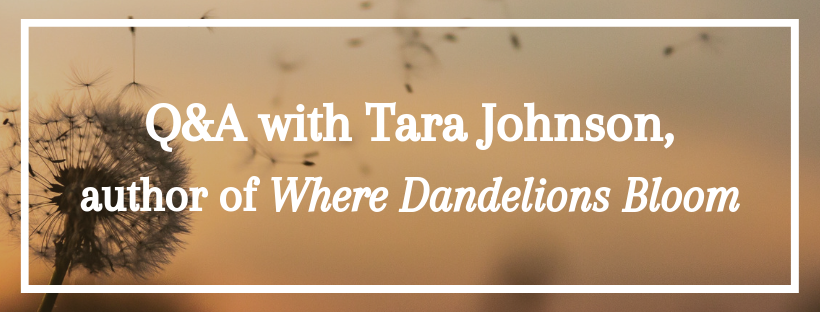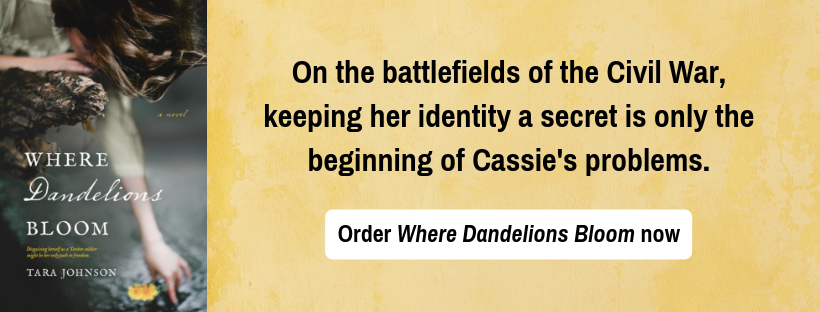
In this Q&A with Where Dandelions Bloom author Tara Johnson, find out about the real woman the book’s heroine Cassie Kendrick is based on, and read about some of the challenges women like her might have faced during the war.
In Where Dandelions Bloom, Cassie Kendrick disguises herself as a Union soldier and runs away to fight in the Civil War. Was there a real person who inspired you to write Cassie’s story? How did you come across that individual’s story?

Cassie is based on real-life Civil War hero Sarah “Emma” Edmonds. Emma enlisted to escape her father’s plans to marry her off to a despicable man and ended up being a highly prized spy and soldier for the Union Army. I discovered Emma’s story while visiting a museum in Savannah, Georgia, and spent months reading everything I could find about her.
Can you talk about challenges women like Emma Edmonds would have faced during the Civil War? What risks did women like Emma run if their real identities were discovered?
Life was extremely difficult for women in war camp and compound that with the constant deception they bore. They were continually aware of any mannerisms or inflections that might give away their gender. Keeping up with the rigors of heavy work, drilling, and marches over rough terrain (on average around fifteen miles a day) with limited food and weather exposure would tax even the toughest soldier, yet the harsh conditions are what made so many of them able to hide their identity as well as they did. Soldiers rarely bathed because washing caused their woolen uniforms to shrink and tear apart at the stitches, so most soldiers never took off their grimy clothes. The female menstrual cycle often stopped completely under the physical strain and malnutrition. Those who continued to cycle found their situation was easily masked by the bloodstains and injuries of war, either from carrying wounded friends or their own injuries.
The unfortunate women whose identities were discovered were returned home in shame, saw their name smeared through major newspapers, or most often, were sent to prison for extended periods of time. Several were even declared insane because they believed themselves to be heroic like Joan of Arc and were sent to asylums. Arrests were often a poor deterrent though. Mary Jane Green was arrested and imprisoned seven times and returned to her regiment to serve each time.
What’s one of the most intriguing historical details you uncovered in your research for Where Dandelions Bloom and wove into the novel?
This story stretched me completely outside my comfort zone in every way. The amount of research was staggering, but one of the biggest things that surprised me was how many young children fought in the war. Jonah Phifer was created after reading about the youngest Civil War soldier on record . . . he was only nine years old!
Gabriel Avery is a handsome young war photographer who develops a relationship with Cassie in the story. Was there a real person who served as inspiration for Gabriel? Why cast Gabriel as a photographer in the novel?
Gabriel was created completely from my own imagination, but I spent quite a bit of time researching Civil War photographers to find out about their various backgrounds, motivations, and the technical processes involved in capturing images using the wet plate process. I needed a love interest for Cassie who could travel alongside her regiment but not be duty bound to obey the orders of military commanders the way a private would. I wanted him to have some freedom to move and provide other aspects of life during the war. I love the imagery behind photography too. There is no denying a picture captures truth, but the photographer must decide where to point the camera. The idea of perspective and training our eyes to see beauty is something I enjoyed exploring in this story.
Can you share some facts that readers may not know about Civil War–era photography or the photographers who were capturing images from the war?
I had no idea they used traveling darkrooms. The idea of Gabriel’s “Whatsit” is a direct historical cameo from Mathew Brady’s own personal traveling darkroom. The soldiers had never seen anything like it and kept joking around asking, “What is it? That’s the craziest-looking wagon we’ve ever seen!” The sheer amount of chemicals, time, and patience they needed to produce each photograph is amazing.
Have you visited some of the sites or battlefields you wrote about in the novel? If so, how did that help you visualize and create scenes in Where Dandelions Bloom?
I wasn’t able to visit any of the specific battlefields, but I was honored to visit a Civil War reenactment performance an hour from our home. The actors and historians did a phenomenal job bringing the past to life. The boom of the cannon and artillery fire is a teeth-rattling, bone-jarring experience.
Just for fun: What’s your favorite scene featuring Cassie and Gabriel in the novel? Why is it your favorite?
Anytime they are fighting! Ha! The sparks between them are so vibrant and passionate, yet they have this undeniable pull. I loved writing those scenes because it was easy to see how both of them were right in their own perspective yet desperately wanted to convince the other to their way of thinking. That’s how it is for most relationships, I think. We always think we’re the hero in our own story.

Where Dandelions Bloom by Tara Johnson
Cassie Kendrick is on the run. Her abusive father arranged her marriage to a despicable man, but she’s discovered an escape. Disguised as a man, Cassie enlists in the Union army, taking the name Thomas Turner. On the battlefields of the Civil War, keeping her identity a secret is only the beginning of her problems, especially after she meets Gabriel Avery, a handsome young photographer.
Anxious to make his mark on the world and to erase the darkness and guilt lurking from his past, Gabriel works with renowned photographer Matthew Brady to capture images from the front lines of the war. As Gabriel forges friendships with many of the men he encounters, he wonders what the courageous, unpredictable Thomas Turner is hiding.
Battling betrayal, their own personal demons, and a country torn apart by war, can Cassie and Gabriel learn to forgive themselves and trust their futures to the God who births hope and healing in the darkest places?

